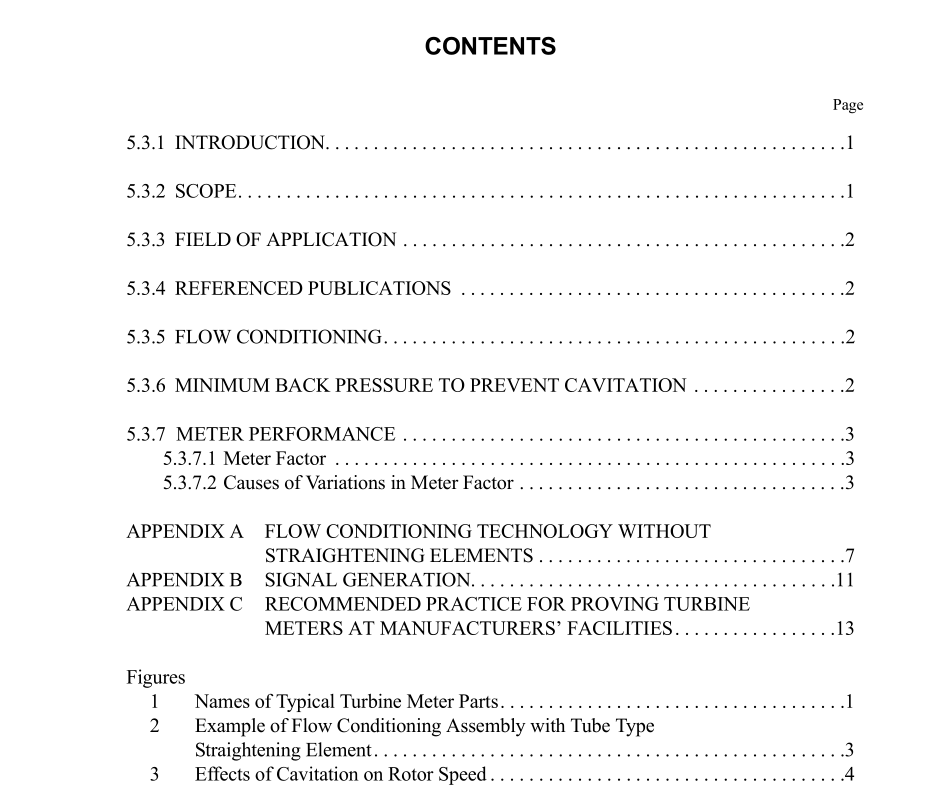API MPMS 5.3 pdf download

API MPMS 5.3 pdf download.Manual of Petroleum Measurement Standards Chapter 5—Metering
5.3.5 Flow Conditioning
5.3.5.1 The performance of turbine meters may be affected by swirl and non-uniform velocity profiles that are induced by upstream and downstream piping configurations, valves, pumps, fittings, joint misalignment, protruding gaskets, weld- ing projections, or other obstructions. Flow conditioning shall be used to overcome the adverse effects of swirl and non-uni- form velocity profiles on turbine meter performance. 5.3.5.2 Flow conditioning requires the use of sufficient lengths of straight pipe or a combination of straight pipe and flow conditioning elements that are inserted in the meter run upstream (and downstream, if flow through the meter is bidi- rectional) of the turbine meter (see Figure 2). 5.3.5.3 When only straight pipe is used, the liquid shear, or internal friction between the liquid and the pipe wall, shall be sufficient to accomplish the required flow conditioning. Appendix A should be referred to for guidance in applying the technique. Experience has shown that in many installa- tions (e.g., downstream of a simple elbow or Tee) a straight pipe length of 20 meter-bore diameters upstream of the meter and 5 meter-bore diameters downstream of the meter often provides effective flow conditioning.5.3.5.4 For severe swirl, such as generated by two close coupled elbows out-of-plane (i.e., non-symmetrical swirl) or by a header (i.e., dual symmetrical swirl), a straightening ele- ment (i.e., swirl breaker) type of flow conditioner is required. These types of swirl are slow to dissipate in straight pipe, often existing after 100+ diameters of straight pipe. 5.3.5.5 A straightening element or swirl-breaker type of flow conditioner usually consists of a cluster of tubes, vanes, or equivalent devices that are inserted longitudinally in a sec- tion of straight pipe (see Figure 2). Straightening elements effectively assist flow conditioning by eliminating swirl. Straightening elements may also consist of a series of perfo- rated plates or wire-mesh screens, but these forms normally cause a larger pressure drop than do tubes or vanes. 5.3.5.6 Proper design and construction of the straightening element is important to ensure that swirl is not generated by the straightening element since swirl negates the function of the flow conditioner. The following guidelines are recom- mended to avoid the generation of swirl: a. The cross-section should be as uniform and symmetrical as possible. b. The design and construction should be rugged enough to resist distortion or movement at high flow rates. c. The general internal construction should be clean and free from welding protrusions and other obstructions.5.3.5.7 Isolating type flow conditioners, which produce a swirl-free, uniform velocity profile, independent of upstream piping configurations, are typically more sophisti- cated, expensive and higher pressure drop than simple straightening element type flow conditioners. However, in certain installations, they provide a performance advantage and should be considered. 5.3.5.8 Flanges and gaskets shall be internally aligned, and gaskets shall not protrude into the liquid stream. Meters and the adjoining straightening section shall be concentrically aligned.
5.3.7.2.1 FLOW RATE CHANGES
At the low end of the flow rate range the meter factor curve may become less linear and less repeatable than it is at the medium and higher rates (see Figure 4, Applications A and B). If a plot of meter factor versus flow rate has been devel- oped for a particular liquid, and other variables are constant, a meter factor may be selected from the plot for flow rates within the meter’s operating range; however, for greatest accuracy, the meter should be reproved at the new operating flow rate.









